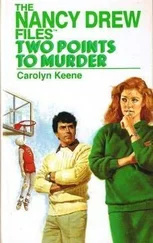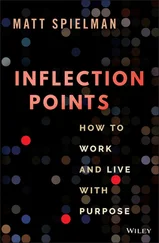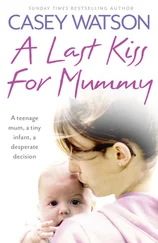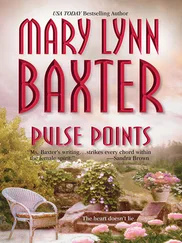To lead private-sector fundraising for Katrina victims, I had tapped an unlikely duo: Dad and Bill Clinton. Katrina was actually their encore performance. After a massive tsunami struck Southeast Asia in December 2004, they had teamed up at my request and raised more than $1 billion for the victims. As they traveled the world together, the former presidents—41 and 42, as I called them—developed a bond. Dad rose above the disappointment of 1992 and embraced his former rival. I appreciated that Bill treated Dad with deference and respect, and I grew to like him. When I asked them to lead another fundraising drive after Katrina, they agreed immediately. Mother called me afterward. “I see you’ve reunited your father and your stepbrother,” she quipped.
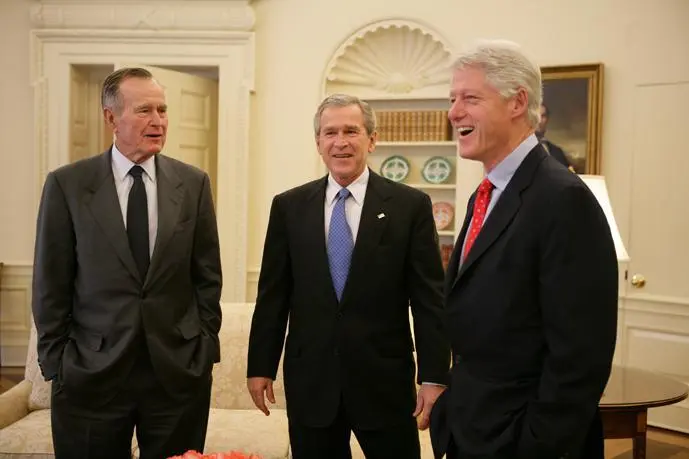
With Dad and Bill Clinton in the Oval Office. White House/Eric Draper
Unfortunately, the spirit of generosity did not carry over to everyone. At an NBC telethon to raise money for Katrina victims, rapper Kanye West told a primetime TV audience, “George Bush doesn’t care about black people.” Jesse Jackson later compared the New Orleans Convention Center to the “hull of a slave ship.” A member of the Congressional Black Caucus claimed that if the storm victims had been “white, middle-class Americans” they would have received more help.
Five years later, I can barely write those words without feeling disgusted. I am deeply insulted by the suggestion that we allowed American citizens to suffer because they were black. As I told the press at the time, “The storm didn’t discriminate, and neither will the recovery effort. When those Coast Guard choppers, many of whom were first on the scene, were pulling people off roofs, they didn’t check the color of a person’s skin.”
The more I thought about it, the angrier I felt. I was raised to believe that racism was one of the greatest evils in society. I admired Dad’s courage when he defied near-universal opposition from his constituents to vote for the Open Housing Bill of 1968. I was proud to have earned more black votes than any Republican governor in Texas history. I had appointed African Americans to top government positions, including the first black woman national security adviser and the first two black secretaries of state. It broke my heart to see minority children shuffled through the school system, so I had based my signature domestic policy initiative, the No Child Left Behind Act, on ending the soft bigotry of low expectations. I had launched a $15 billion program to combat HIV/AIDS in Africa. As part of the response to Katrina, my administration worked with Congress to provide historically black colleges and universities in the Gulf Coast with more than $400 million in loans to restore their campuses and renew their recruiting efforts.
I faced a lot of criticism as president. I didn’t like hearing people claim I had lied about Iraq’s weapons of mass destruction or cut taxes to benefit the rich. But the suggestion that I was a racist because of the response to Katrina represented an all-time low. I told Laura at the time that it was the worst moment of my presidency. I feel the same way today.

During Week Two of the Katrina response, Mike Chertoff recommended that we make a personnel change. State and local officials had been complaining about the slowness of FEMA, and Chertoff told me he had lost confidence in Director Mike Brown. He felt the FEMA director had frozen under the pressure and become insubordinate. I accepted Chertoff’s recommendation to bring in Vice Admiral Thad Allen—the chief of staff of the Coast Guard who had done a brilliant job leading the search-and-rescue efforts—as the principal federal officer coordinating operations in the Gulf Coast.
On Sunday of that week, Day Fourteen, I made my third visit to the Gulf Coast. I choppered onto the USS Iwo Jima , which had docked in the Mississippi River . Two years earlier, I had deployed the Iwo Jima to free Liberia from the dictator Charles Taylor. It was surreal to be standing aboard an amphibious assault ship overlooking a major American city suffering the wounds of a violent storm.
The next morning, we boarded ten-ton military trucks for a tour through New Orleans. The Secret Service was anxious. The drive was one of very few times a president had traveled through a major metropolitan city in an open-top vehicle since the Kennedy assassination in 1963. We had to dodge dangling power lines and drive through deep pools of standing water. Virtually all the houses were still abandoned. Some of their walls were spray-painted with the date they had been searched and the number of bodies discovered inside. I saw a few people wandering around in a daze. Nearby was a pack of mangy dogs scavenging for food, many with bite marks on their bodies. It was a vivid display of the survival-of-the-fittest climate that had overtaken the city.
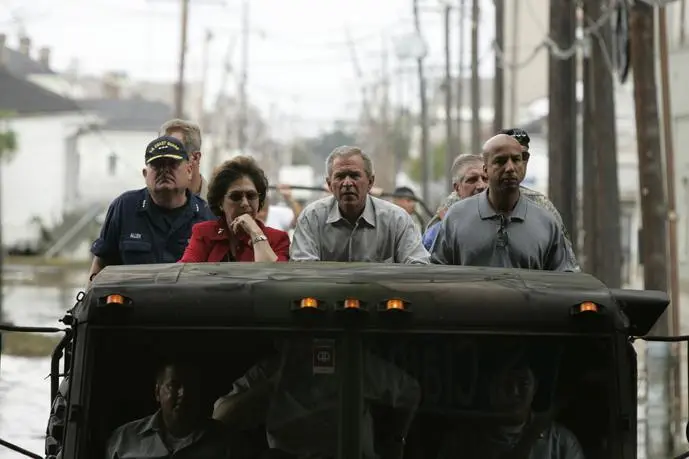
Touring the destruction Katrina had done to the city. White House/Paul Morse
On September 15, Day Eighteen, I returned to New Orleans to deliver a primetime address to the nation. I decided to give the speech from Jackson Square, named for General Andrew Jackson, who defended New Orleans against the British at the end of the War of 1812. The famous French Quarter landmark had suffered minimal damage during the storm.
I viewed the speech as my opportunity to explain what had gone wrong, promise to fix the problems, and lay out a vision to move the Gulf Coast and the country forward. Abandoned New Orleans was the eeriest setting from which I had ever given a speech. Except for generators, the power was still out in the city. In one of the world’s most vibrant cities, the only people around were a handful of government officials and the soldiers from the 82nd Airborne.
With St. Louis Cathedral bathed in blue light behind me, I began Good evening. I’m speaking to you from the city of New Orleans—nearly empty, still partly under water, and waiting for life and hope to return. …Tonight I … offer this pledge of the American people: Throughout the area hit by the hurricane, we will do what it takes, we will stay as long as it takes, to help citizens rebuild their communities and their lives. And all who question the future of the Crescent City need to know there is no way to imagine America without New Orleans, and this great city will rise again.
I laid out a series of specific commitments: to ensure victims received the financial assistance they needed; to help people move out of hotels and shelters and into longer-term housing; to devote federal assets to cleaning up debris and rebuilding roads, bridges, and schools; to provide tax incentives for the return of businesses and the hiring of local workers; and to strengthen New Orleans’s levees to withstand the next big storm. I continued: Four years after the frightening experience of September the 11th, Americans have every right to expect a more effective response in a time of emergency. When the federal government fails to meet such an obligation, I, as president, am responsible for the problem, and for the solution. So I’ve ordered every Cabinet Secretary to participate in a comprehensive review of the government response to the hurricane. This government will learn the lessons of Hurricane Katrina.

I took those promises seriously. Over the coming months, I worked with Congress to secure $126 billion in rebuilding funds, by far the most for any natural disaster in American history. I decided to create a new position to ensure that one person was accountable for coordinating the rebuilding and ensuring the money was spent wisely. Thad Allen held the role at first. When I nominated him to be commandant of the Coast Guard, I asked Don Powell, a fellow Texan and former chairman of the Federal Deposit Insurance Commission, to take his place.
Читать дальше







